WhatsApp:
+86 18866361895
WhatsApp:
+86 18866361895
As an important hub for urban food supply, the food safety of farmers' markets is directly related to consumer health. To meet the high-frequency and diversified testing needs,···
 在线咨询
在线咨询

As an important hub for urban food supply, the food safety of farmers' markets is directly related to consumer health. To meet the high-frequency and diversified testing needs, the rapid testing laboratory needs to be equipped with intelligent and integrated equipment covering core projects such as pesticide residues, veterinary drug residues, heavy metals, microorganisms, and illegal additives. Starting from the testing items, systematically sort out the laboratory instrument configuration plan.
1、 Core testing equipment: precise coverage of five major risk areas
Pesticide residue detector
Pesticide residue detector: Based on the principle of cholinesterase activity inhibition, it quickly screens for organophosphate and carbamate pesticides through spectrophotometry.
Portable pesticide residue rapid testing card: integrating colloidal gold labeling technology, qualitatively detecting pesticide residues through color changes of test strips, without the need for professional instruments, providing results within 3 minutes, suitable for rapid screening on site.
Veterinary drug residue detector
Fluorescence quantitative PCR instrument: for animal derived foods (such as meat and aquatic products), it detects antibiotic residues (such as chloramphenicol and sulfonamides) by amplifying specific gene fragments. The sensitivity is 10 times higher than traditional ELISA method, and the detection time is shortened to 2 hours.
Veterinary drug residue detector: The veterinary drug residue detector can quickly detect clenbuterol hormone food safety items, including clenbuterol hydrochloride, salbutamol, ractopamine, diethylstilbestrol, veterinary drug residues, antibiotic residues, fungal toxin residues, animal disease residues, etc.
Heavy metal detector
Food heavy metal detector: The food heavy metal detector can simultaneously detect heavy metal elements such as lead, cadmium, mercury, arsenic, etc., with low detection limits and high detection accuracy.
X-ray fluorescence spectrometer: By exciting the surface elements of the sample with X-rays to produce characteristic fluorescence, non-destructive testing of heavy metals such as copper and zinc can be achieved, with a detection time reduced to 30 seconds per sample. It is suitable for dried foods such as tea and traditional Chinese medicine.
Microbial detector
ATP bioluminescence detector: It quickly evaluates the degree of microbial contamination on the surface of food by detecting the content of adenosine triphosphate (ATP), and provides results within 15 seconds. It is suitable for screening the hygiene status of fresh meat and cooked food products.
Illegal additive detector
Raman spectrometer: By utilizing the vibrational characteristics of substance molecules, a characteristic spectral library of illegal additives (such as Sudan Red and melamine) is established to achieve non-destructive and rapid screening, with detection time reduced to 1 minute per sample. It is suitable for high-risk categories such as seasonings and dairy products.
2、 Preprocessing and auxiliary equipment: key to improving detection efficiency
Pretreatment all-in-one machine: It integrates functions such as crushing, homogenization, extraction and purification, and supports user-defined pretreatment processes. For example, the gel purification module for high-fat samples (such as nuts) can automatically remove grease interference, and the processing time is 60% shorter than that of traditional methods.
Intelligent nitrogen blowing concentrator: adopting microchannel design, precise control of nitrogen flow rate to 0.1L/min, avoiding sample splashing. Equipped with parallel evaporation module, it can process 8 samples simultaneously, increasing concentration efficiency by 3 times.
Electronic balance and pH meter: High precision balance (accuracy 0.0001g) is used for weighing reagents, and pH meter (accuracy ± 0.01) monitors the acidity and alkalinity of the extraction solution to ensure experimental reproducibility.
3、 Suggestions for laboratory construction and management
Space layout: Divide the sample receiving area, pre-processing area, testing area, and data management area according to the testing process, equipped with independent ventilation systems and biosafety cabinets to prevent cross contamination.
Personnel training: Regularly organize operators to participate in equipment usage, standard interpretation, and emergency response training to ensure the accuracy of test results.
Data management: Deploy a laboratory information management system to achieve sample registration, automatic uploading of detection data, abnormal value warning and report generation, and improve laboratory management efficiency.
Through the collaborative configuration of core detection equipment covering five major risk areas and intelligent pre-processing systems, the agricultural market rapid inspection laboratory can build a rapid response mechanism of "15 minute initial screening -2 hours precise quantification", providing technical guarantee for consumers' "tongue safety".